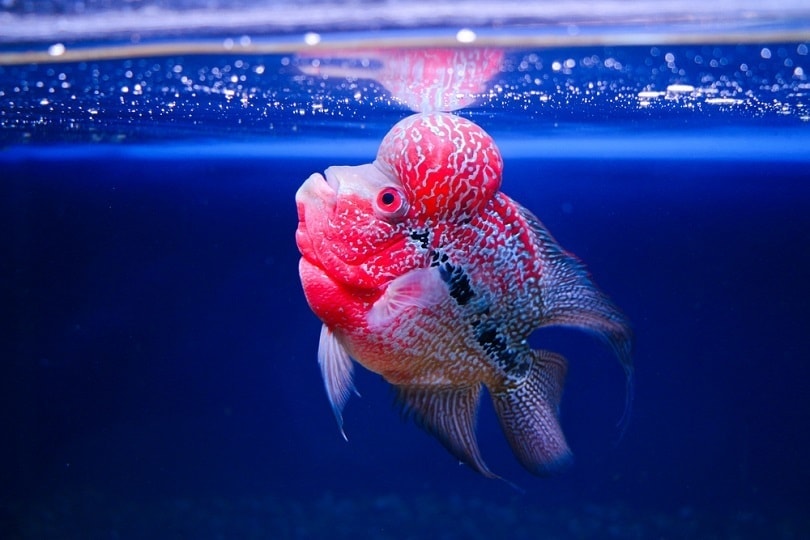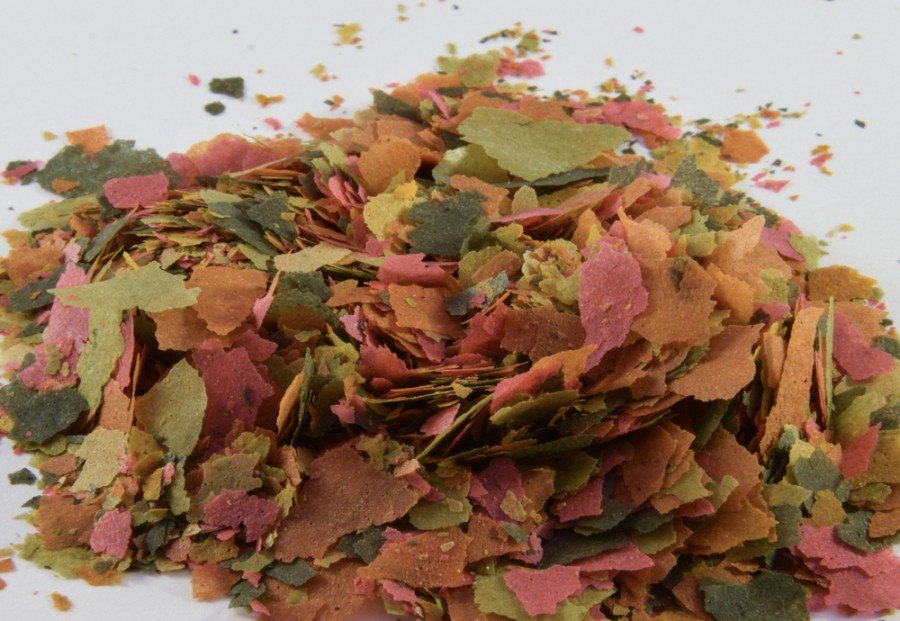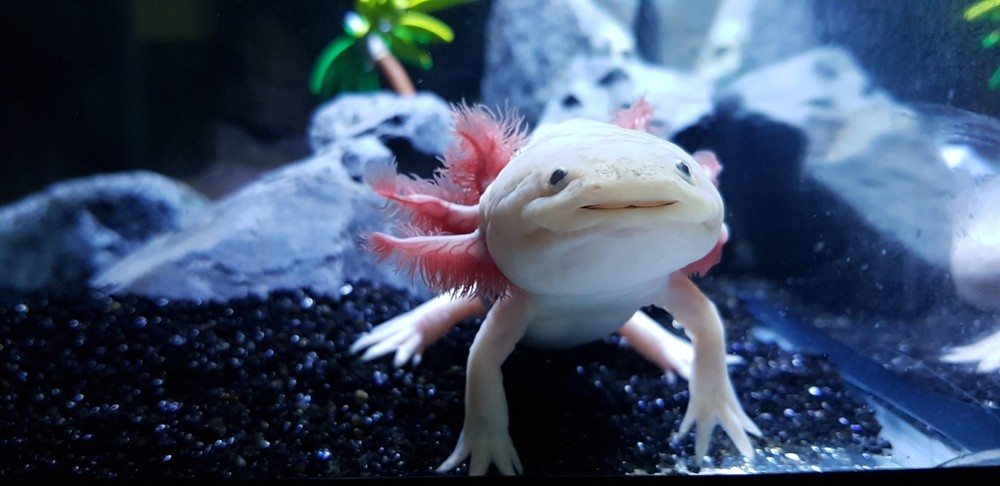Flowerhorn Cichlid: Care Guide, Types, Lifespan & Breeding (With Pictures)

Updated on

These exotically attractive fish are a must-have for all cichlid lovers. The Flowerhorn cichlid is unique and attractive, both on the inside and with their personalities. The Flowerhorn cichlid easily becomes part of their family and is greatly appreciated by long-term owners for their characteristics. Flowerhorns are hardy and are one of the most sought of cichlid amongst aquarists.
These mesmerizing fish are great for intermediates in the tropical fish-keeping hobby. They make a great first-time cichlid owner fish, and you will adore their activeness amongst a substantially large aquarium. This article aims to provide you with every aspect of Flowerhorn fish care and facts.

Facts about Flowerhorn Cichlids
| Species Name: | Paranthropus |
| Family: | Cichlidae |
| Care Level: | Intermediate to advanced |
| Temperature: | 26.5°C to 30°C |
| Temperament: | Semi-aggressive |
| Color Form: | Patterned: red, green, purple, blue, yellow |
| Lifespan: | 10 to 12 years |
| Size: | Extremely large: 16 inches |
| Diet: | Omnivore |
| Minimum Tank Size: | 80 gallons for a juvenile ≥6 to 8 inches & 160 gallons for an adult ≤12 inches |
| Tank Set-Up: | Freshwater: tropical, plastic, or plant decoration. The tank should have more length and width than height. |
| Compatibility: | Limited |
Flowerhorn Overview
Flowerhorn fish were created by Chinese fish keepers for the sole purpose of producing an exotic variation of cichlid. Flowerhorns do not naturally occur in the wild and have no specific origin except in Chinese laboratories. The only close relatives can be dated back to the South African Cichlids. Since many owners irresponsibly dispose or release these fish into waterways, they end up in wild rivers where they breed and replicate. This can impose a risk to the natural ecosystem and the fish should not be flushed or released when you can no longer care for them or if they have passed.
Flowerhorns grow exceptionally large to a whopping 16 inches! They can also live for 12 years when cared for appropriately. They have a similar body to their South African ancestors with a spherical head shape and elongated body. This is what makes them one of the most attractive species of cichlid on the market. Flowerhorns introduced to the public in 1996 and were sold for a large sum of money. Flowerhorns are known to quickly form a bond with their owner and become interactive behind the glass. They are regarded as special fish within the aquarium hobby and are well respected.

How Much Do Flowerhorns Cost?
Flowerhorns are not widely available, and you may have trouble locating a reputable source. They are commonly found from reputable breeders online. This means you will have to ship them to your doorstep. They are not budget-friendly fish and cost anywhere between $30 to $50. The cost of Flowerhorns depends on several factors, like their age, coloration, size, and rarity. If you choose to order your Flowerhorn online, you will have to pay for the fast shipping of livestock, which can add a bonus of $5 to $15 on their overall price. The cost is worth their uniqueness they offer to aquarists and few regrets ever purchasing a Flowerhorn cichlid.
Typical Behavior & Temperament
Just like most cichlids, Flowerhorns are semi-aggressive. They will display a territorial nature towards other fish who are then at risk of being bullied. Not only does this behavior cause stress to the bullied fish, but your Flowerhorn as well. Flowerhorns do not get along well with foreign species of fish and will chase them around the tank till the point of exhaustion. Flowerhorns are not natural schooling fish and enjoy swimming in pairs, ideally with a mate.
If you choose compatible fish to house with your Flowerhorn, you can lower the chances of potential dominance issues. Due to the size of these giants, they are slow swimmers and move around the tank at a slow pace. The bulk of their body adds unnatural weight that inhabits natural cichlid movements. These fish do not have a specific swim layer in the tank and will swim both up and down.

Appearance & Varieties
Flowerhorns have an elongated body with compressed sides. Although there are variations of Flowerhorns with either a disc shape or even rounded sides. They have a dorsal and anal fin that stretches to the base of their tail. Flowerhorns have deep-set eyes and their most distinguishable feature is their abnormally rounded head that looks like a golf ball. This makes them attractive yet humorous.
Their iconic head shape is what has brought in the modern attraction of consumers. No other species of fish have this defining appearance, and this helps Flowerhorns to become more identifiable. Their colorations are accompanied by intricate patterns and various colors. They have small lines that are typically yellow, with an orange body. This is one of their most standard colors. They also come in patterns with colors like blue, red, green, and even a bruise color purple.
Flowerhorns anal and dorsal fins have a braided ending and their tail and thin and rounder than their other fins. Their elegant pectoral fins can sometimes appear translucent and are much shorter than their other fins. Rare color morphs of the flower horn fish are golden to light purples. Some may even appear a fiery red color. Flowerhorns can meet your appearance needs by being both mono-colored fish and display exotic mixes. All the strains have your appearance desires.
The body of the Flowerhorn was selectively bred and produced from the South African cichlid, which is how they got their mega-sized head.
How to Take Care of Flowerhorns
Habitat, Tank Conditions & Setup
Tank/aquarium size: Flowerhorns grow to an extremely large size at 16 inches. This makes them one of the largest fish available in captivity. Care should be taken to purchase a large tank for one Flowerhorn. A general guideline is 80 gallons at an ethical minimum for juvenile Flowerhorns, and 160 gallons for an adult. If your Flowerhorn has grown to its full-size potential of 16 inches, a tank over 200 gallons is recommended. If you plan to keep more than one Flowerhorn in a tank, an additional 80 gallons should be added on from the minimum tank size. This ensures your Flowerhorn is housed comfortably.
Water temperature & pH: Flowerhorns were bred in warm tropical waters and require this in captivity. The tank should be heated to a preset temperature between 26.5°C to 30°C. The water should not fluctuate. The most recommended temperature for these fish is to meet their requirements in the middle with a temperature of 28°C. The water in your Flowerhorns tank should have a pH between 7.5 to 8.0. This means that they prefer more alkaline water.
Substrate: These fish are not fussy with substrates and do well with gravel, aquarium sands, and even large pebbles. If you find it difficult to fill a large tank with a substrate, you can use algae mats or even keep your tank bare bottom. Although a tank without substrate has a difficult time growing large amounts of essential beneficial bacteria.
Plants: Flowerhorns require sparsely decorated tanks and do well with both fake and live plants. Space between the decorations and plants is essential to ensure your Flowerhorn has enough space to comfortably swim around. This includes both around and through the plants.
Lighting: Flowerhorns can tolerate the use of moderate artificial or natural light from a window. Make sure you do not leave the light on for more than 10 hours, as they require darkness to sleep.
Filtration: Flowerhorns produce large waste particles and therefore require a filter that can filter ten times the water volume in a minute. The filter should be large and cater towards the size of the tank. Two filters on either side of the large tank can ensure maximum filtration takes place. Flowerhorns have also been known to be messy eaters, this can foul up the water quite quickly.

Are Flowerhorns Good Tank Mates?
Due to their aggressive nature, Flowerhorns do not make good tankmates. There are very few tank mates who will get along with your Flowerhorn and vice versa. Flowerhorns are extremely territorial and have been known to chase tank mates out of the tank. To avoid finding a bullied fish out of the water by your tank, choosing the correct tank mates for your fish is important.
Flowerhorns have an extremely limited foreign fish tolerance and you should keep an aquarium hood or canopy to stop fish from being chased out of the tank. Although, there are still a few fish out there that can be carefully housed with your Flowerhorn. Flowerhorns were bred in captivity and therefore do not naturally know life in the wild, where they will adapt to encounters with other fish and invertebrates. When we want to decide on the best tank mates, we should take into consideration the natural tank mates that their ancestors shared a water source with.
Below is our most recommended tank mate list for Flowerhorns, although none are claimed to not be bullied slightly by Flowerhorns.
- Leopard pleco
- Jaguar cichlids
- Common plecos
- Clown plecos
- Gourami
- Lowland cichlids
- Bushy nose catfish
- Spotted Hope
- Armored catfish
- Oscar cichlids
What to Feed Your Flowerhorn
Flowerhorns are naturally omnivores and will eat both plant and meat-based foods. It is important to ensure your Flowerhorn is receiving all its necessary vitamins and minerals while catering to their optimal guaranteed analysis. Flowerhorns will happily eat anything that makes its way into the tank, including small fish. A protein-rich diet is recommended and makes up most of their optimal food. Quality is important when it comes to Flowerhorns and this may mean you need to spend extra money on the top brands.
Some good foods to feed Flowerhorns are shrimp, commercial cichlid foods in the form of pellets or flakes, dried grasshoppers, small fish, bloodworms, tubifex worm cubes, and even dried crickets. It is also important to incorporate vegetation into the diet like leafy greens, peas, and cucumber. Flowerhorns are also known to consume some live plants within the aquarium. Food should be consumed within 3 minutes to avoid the tank from fouling up. Since their food is quite large, you can use an aquarium net to capture any leftovers.
Keeping Your Flowerhorn Healthy
If you follow all their necessary care requirements, you will be able to successfully raise a happy and healthy Flowerhorn. Provide your fish with a powerful filter that has a moderate flow. Flowerhorns love clean water with no levels of ammonia or nitrite and only a maximum of 20ppm (parts per million) of nitrates. Doing regular water changes helps to keep the water clean and free of pollutants.
Feed them a diet rich in protein and vegetation to keep their organs and digestion in check. They require a well-aerated tank to take insufficient oxygen. No sharp objects or gravel should be in the tank as they are susceptible to poking themselves when they try to squeeze their large bodies through small openings. If your Flowerhorn does fall ill, you should immediately treat them with quality medications that are formulated for their illness. Avoid overfeeding your Flowerhorn and keep to a rotating schedule of healthy foods.
Breeding
Flowerhorn fish are not hard to breed in captivity, due to them being created and bred primarily in a captive environment. If you keep them in their ideal conditions, you will have a healthy pair of adult Flowerhorns to produce healthy offspring. Although breeding them is not a tricky task, you should prepare the right breeding tank set up beforehand. You will need to set up a large tank where you will breed the healthy pair. The tank should be free of a substrate and sparse smooth decorations like live or silicone plants.
You should expect your Flowerhorns to be sexually mature at 2 years old, to which you can then attempt to breed them. The spawning process requires minimal human intervention, and the female will lay between 800 to 900 eggs on smooth objects. This can include plants or rocks. The male will then fertilize the eggs and may become territorial towards the female after the mating process.
The fry will begin to hatch after two days should be fed specifically formulated fry food from a pet store or small shrimp. They will start to develop their parent’s characteristics at an early age to which you will be able to identify their coloration and gender.
Are Flowerhorns Suitable For Your Aquarium?
If you have an extremely large freshwater tank that is heated and sparsely decorated, a Flowerhorn may be a good and colorful fish for your aquarium. It is important to make sure their tank is set up appropriately and that there are no unsuitable tank mates. You should have basic knowledge of their care and requirements and be fully aware of their full-grown size.
These fish are commonly exposed after a few years when the owner realizes they can no longer cater towards their large size. It is best to avoid choosing such a big fish for a tank if you have no plans to upgrade. Putting the fish up for adoption or sale is recommended instead of or releasing them. If you can house them properly, provide them with a good diet, and ensure all efforts are taken to keep them healthy, the exotic and attractive Flowerhorn fish will make a lovely addition to your aquarium.
Featured Image Credit: Huy Thoai, Shutterstock












